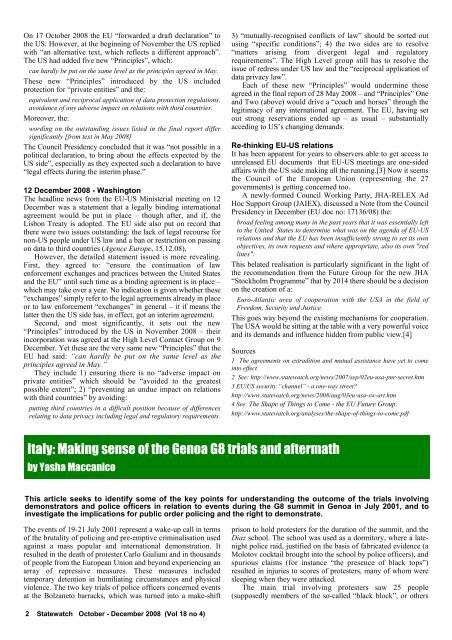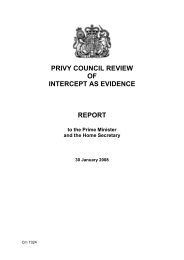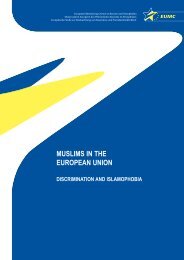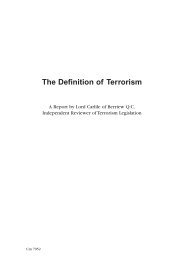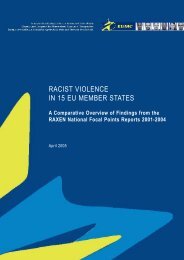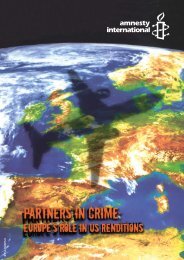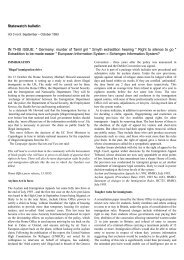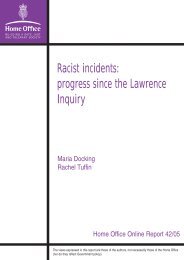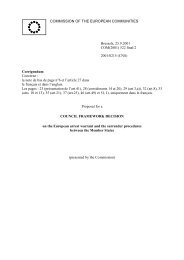Vol 18 no 4 - Statewatch
Vol 18 no 4 - Statewatch
Vol 18 no 4 - Statewatch
You also want an ePaper? Increase the reach of your titles
YUMPU automatically turns print PDFs into web optimized ePapers that Google loves.
On 17 October 2008 the EU “forwarded a draft declaration” to<br />
the US. However, at the beginning of November the US replied<br />
with “an alternative text, which reflects a different approach”.<br />
The US had added five new “Principles”, which:<br />
can hardly be put on the same level as the principles agreed in May.<br />
These new “Principles” introduced by the US included<br />
protection for “private entities” and the:<br />
equivalent and reciprocal application of data protection regulations,<br />
avoidance of any adverse impact on relations with third countries.<br />
Moreover, the:<br />
wording on the outstanding issues listed in the final report differ<br />
significantly [from text in May 2008]<br />
The Council Presidency concluded that it was “<strong>no</strong>t possible in a<br />
political declaration, to bring about the effects expected by the<br />
US side”, especially as they expected such a declaration to have<br />
“legal effects during the interim phase.”<br />
12 December 2008 - Washington<br />
The headline news from the EU-US Ministerial meeting on 12<br />
December was a statement that a legally binding international<br />
agreement would be put in place – though after, and if, the<br />
Lisbon Treaty is adopted. The EU side also put on record that<br />
there were two issues outstanding: the lack of legal recourse for<br />
<strong>no</strong>n-US people under US law and a ban or restriction on passing<br />
on data to third countries (Agence Europe, 15.12.08).<br />
However, the detailed statement issued is more revealing.<br />
First, they agreed to: “ensure the continuation of law<br />
enforcement exchanges and practices between the United States<br />
and the EU” until such time as a binding agreement is in place –<br />
which may take over a year. No indication is given whether these<br />
“exchanges” simply refer to the legal agreements already in place<br />
or to law enforcement “exchanges” in general – it if means the<br />
latter then the US side has, in effect, got an interim agreement.<br />
Second, and most significantly, it sets out the new<br />
“Principles” introduced by the US in November 2008 – their<br />
incorporation was agreed at the High Level Contact Group on 9<br />
December. Yet these are the very same new “Principles” that the<br />
EU had said: “can hardly be put on the same level as the<br />
principles agreed in May.”<br />
They include 1) ensuring there is <strong>no</strong> “adverse impact on<br />
private entities” which should be “avoided to the greatest<br />
possible extent”; 2) “preventing an undue impact on relations<br />
with third countries” by avoiding:<br />
putting third countries in a difficult position because of differences<br />
relating to data privacy including legal and regulatory requirements.<br />
3) “mutually-recognised conflicts of law” should be sorted out<br />
using “specific conditions”; 4) the two sides are to resolve<br />
“matters arising from divergent legal and regulatory<br />
requirements”. The High Level group still has to resolve the<br />
issue of redress under US law and the “reciprocal application of<br />
data privacy law”.<br />
Each of these new “Principles” would undermine those<br />
agreed in the final report of 28 May 2008 – and “Principles” One<br />
and Two (above) would drive a “coach and horses” through the<br />
legitimacy of any international agreement. The EU, having set<br />
out strong reservations ended up – as usual – substantially<br />
acceding to US’s changing demands.<br />
Re-thinking EU-US relations<br />
It has been apparent for years to observers able to get access to<br />
unreleased EU documents that EU-US meetings are one-sided<br />
affairs with the US side making all the running.[3] Now it seems<br />
the Council of the European Union (representing the 27<br />
governments) is getting concerned too.<br />
A newly-formed Council Working Party, JHA-RELEX Ad<br />
Hoc Support Group (JAIEX), discussed a Note from the Council<br />
Presidency in December (EU doc <strong>no</strong>: 17136/08) the:<br />
broad feeling among many in the past years that it was essentially left<br />
to the United States to determine what was on the agenda of EU-US<br />
relations and that the EU has been insufficiently strong to set its own<br />
objectives, its own requests and where appropriate, also its own "red<br />
lines".<br />
This belated realisation is particularly significant in the light of<br />
the recommendation from the Future Group for the new JHA<br />
“Stockholm Programme” that by 2014 there should be a decision<br />
on the creation of a:<br />
Euro-Atlantic area of cooperation with the USA in the field of<br />
Freedom, Security and Justice.<br />
This goes way beyond the existing mechanisms for cooperation.<br />
The USA would be sitting at the table with a very powerful voice<br />
and its demands and influence hidden from public view.[4]<br />
Sources<br />
1 The agreements on extradition and mutual assistance have yet to come<br />
into effect.<br />
2 See: http://www.statewatch.org/news/2007/sep/02eu-usa-pnr-secret.htm<br />
3 EU/US security “channel” - a one-way street?<br />
http://www.statewatch.org/news/2008/aug/03eu-usa-sw-art.htm<br />
4 See: The Shape of Things to Come - the EU Future Group:<br />
http://www.statewatch.org/analyses/the-shape-of-things-to-come.pdf<br />
Italy: Making sense of the Ge<strong>no</strong>a G8 trials and aftermath<br />
by Yasha Maccanico<br />
This article seeks to identify some of the key points for understanding the outcome of the trials involving<br />
demonstrators and police officers in relation to events during the G8 summit in Ge<strong>no</strong>a in July 2001, and to<br />
investigate the implications for public order policing and the right to demonstrate.<br />
The events of 19-21 July 2001 represent a wake-up call in terms<br />
of the brutality of policing and pre-emptive criminalisation used<br />
against a mass popular and international demonstration. It<br />
resulted in the death of protester Carlo Giuliani and in thousands<br />
of people from the European Union and beyond experiencing an<br />
array of repressive measures. These measures included<br />
temporary detention in humiliating circumstances and physical<br />
violence. The two key trials of police officers concerned events<br />
at the Bolzaneto barracks, which was turned into a make-shift<br />
prison to hold protesters for the duration of the summit, and the<br />
Diaz school. The school was used as a dormitory, where a latenight<br />
police raid, justified on the basis of fabricated evidence (a<br />
Molotov cocktail brought into the school by police officers), and<br />
spurious claims (for instance “the presence of black tops”)<br />
resulted in injuries to scores of protesters, many of whom were<br />
sleeping when they were attacked.<br />
The main trial involving protesters saw 25 people<br />
(supposedly members of the so-called “black block”, or others<br />
2 <strong>Statewatch</strong> October - December 2008 (<strong>Vol</strong> <strong>18</strong> <strong>no</strong> 4)


